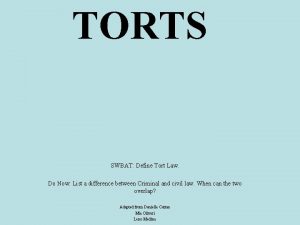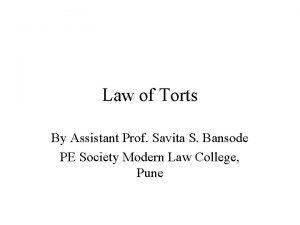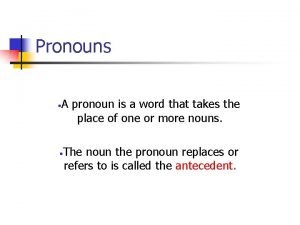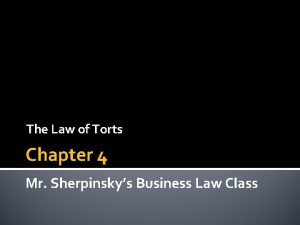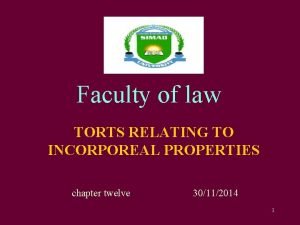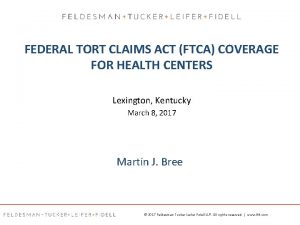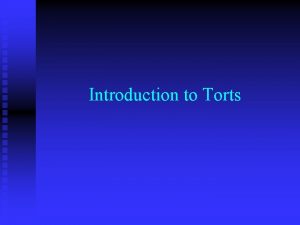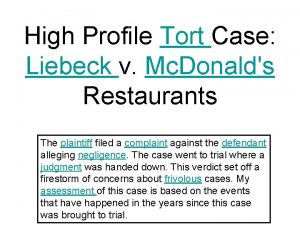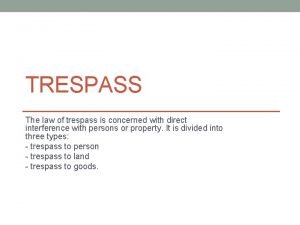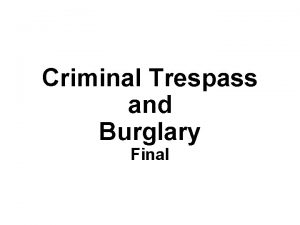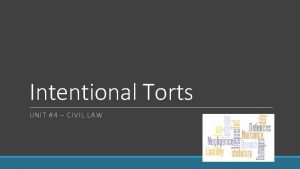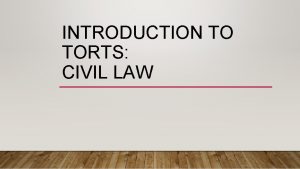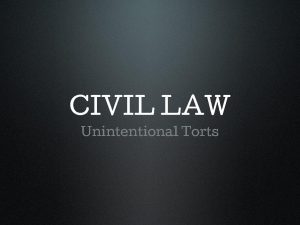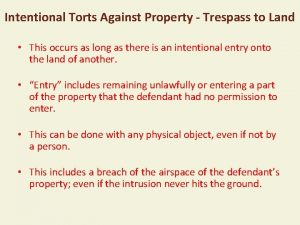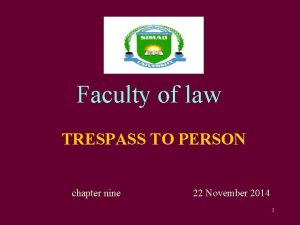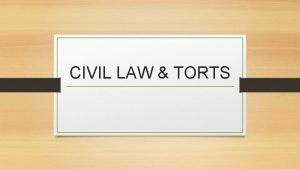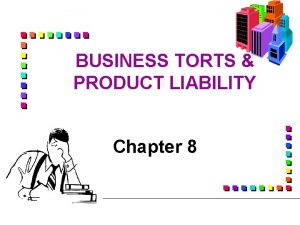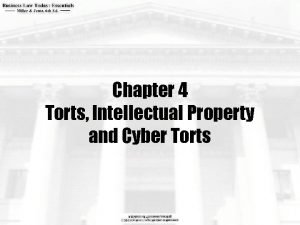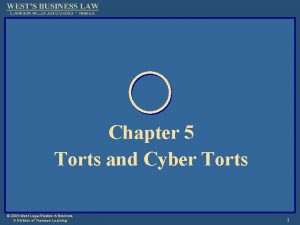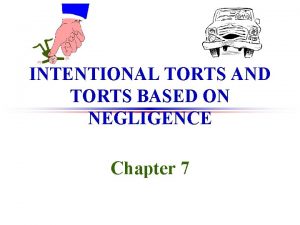LAW OF TORTS TRESPASS TO THE PERSON Trespass















- Slides: 15

LAW OF TORTS TRESPASS TO THE PERSON Trespass to the Person is any intentional or deliberate interference or invasion with the body of another person or his liberty. There are three types; namely: (i) Assault: (ii) Battery: (iii) False Imprisonment: Putting a person in fear of bodily harm. Any contact, touch, force, or bodily harm. Deprivation of personal liberty, movement, or any detention, kidnap or arrest. Where a trespass to person is committed negligently or was as a result of negligence, action is usually brought in the tort of negligence. Take Notice that words alone do not constitute Assault (Tuberville v. Savage (1669) 86 ER 684; R v. Light (1843) ALLER 934 CA). The tort of trespass to person is actionable per se. The Purpose of the law of Assault is to prohibit putting a person in fear of physical interference (including revenge attack) of the body. Examples include: threatening a person with a knife; broken bottle; advancing towards a person shaking your fist and threatening to beat him or her up; striking a person with a stick but which misses the person; etc. Take Notice that it must have an element of threat of violence. Elements: (i) That there was a threat to apply force. (ii) That the act will put a reasonable person in fear of Battery.

See: (i) Stephen v. Myers (1838) 172 ER 735; (ii) R v. St George (1840) 173 ER 921; (iii) R v. Barrett (1980) 72 CAR 212 CA; (iv) Read v. Coker (1853) 138 ER 1437; etc. The Purpose of the law of Battery is to protect the body or dignity of a person from unlawful contact and violence by another person. Take Notice that contact is necessary here. Examples include: Beating with a stick, pouring water on a person, shooting someone with a gun, knocking someone down/running a person down with a motor vehicle, spitting on someone's face or throwing stone at someone, removing a chair from under a person who thereby falls to the ground, pulling someone away from something for his own good, setting a dog to attack a person; etc. Elements: (i) Application of Force. (ii) Intention to apply force.

See: (i) Nash v. Sheen (1953) CLY 3726; (ii) R v. Day (1845) 1 Cox CC 207; (iii) Leon v. Met. Police Commr. (1986) 1 CL 318; etc. The Purpose of the tort of false imprisonment is to protect the fundamental right to personal liberty and right to freedom of movement. Elements of False Imprisonment: (i) Restraint of the Person – Wright v. Wilson (1699) 91 ER 1394; (ii) Restraint must be total – Bird v. Jones (1845) 7 QB 742; See: (i) John Lewis & Co. Ltd. v. Timms (1952) AC 676 HL; (ii) Onitiri v. Ojomo (1954) 21 NLR 19; (iii) The Queen v. Lambo Sokoto (1961) WNLR 27; etc. Defences: (i) Self Defense or Justification; (ii) Defense of Property; (iii) Consent of the Plaintiff; (iv) Medical Treatment/ Medical Care/ Medical Surgery; (v) Inevitable Accident; (vi) Judicial Authority; (vii) Lawful Arrest/ Detention/ Stop and Search.

REMEDIES FOR TRESPASS TO PERSON (i) Declarative Judgment; (ii) Injunction; (iii) Binding over to keep the Peace for a specified period; (iv) Award of Damages; (v) Writ of Habeas Corpus; (vi) Apology; (vii) Escape from Unlawful Custody or Kidnap; (viii) Self Defence.

TRESPASS TO LAND This is any direct interference, invasion or injury to an interest in land which is in the possession of another person. It also consists of the slightest disturbance of the possession of land by a person who cannot show a better right or title to possession. See Eze v. Obiefuna (1995) 6 NWLR pt. 404 pg. 639 SC. The definition of land includes the earth or surface soil; beneath the earth surface or Underground; any building or things attached to or growing on it; the water on it; the airspace above it to an extent reasonable for user; the mineral resources on it (although in Nigeria, the Constitution vests all mineral resources in the Federal Government while the Land Use Act vests all lands in the State Government. Trespass to Land is actionable per se. Examples include the slightest entry of another person’s land; refusing to leave and remaining on land after permission is revoked; projecting anything above land; driving animals into another person’s land; throwing anything or refuse on another’s land; etc.

Elements of Trespass to Land: (i) Direct entry on the land; remaining on it; placing or projecting any object on the land; (ii) The Plaintiff has possession or right to immediate possession of the land; (iii) The entry is without lawful justification. See Smith v. Stone (1647) 82 ER 533; Gregory v. Piper (1829) 109 ER 220; Onasanya v. Emmanuel (1973) 4 CCHCJ 477; Nickolls v. Melbourne (1938) 59 CLR 219; Balogun v. Alakija (1963) 2 All NLR 175. Remedies: (i) Action for Title and Recovery of Land; (ii) Order for Recovery of Possession; (iii) Injunction; (iv) Damages; (v) Re-entry and Defence of property; (vi) Seizure of property in lieu of payment of damages; (vii) Claim of Mesne Profit; (viii)Placing warning notices of keep off to trespassers; etc.

Defences: (i) Possession of a better title; (ii) Jus tertii or acting under the authority of a person having a better title; (iii) Entry to abate a nuisance; (iv) Entry to retake a chattel.

TRESPASS TO CHATTEL A chattel is any moveable property capable of being owned, possessed or controlled and examples include books, cars, furniture vessel, animals, wristwatches, aircraft, etc. The Purpose is to protect all chattels, goods or personal properties of a person who has title/possession by prohibiting all interferences without legal justification. It also protects the rights of ownership or possession of such chattels from all wrongful interferences. The tort is actionable per se. Davies v. Lagos City Council (1973) 10 CCHCJ 151 at 154. In Nigeria, the tort is of three types namely; (i) Trespass to chattels per se (i. e. without a conversion or a detinue of such chattel); (ii) Conversion (i. e. wrongful detention or conversion of goods by detention); and (iii) Detinue. Take Notice that in the United Kingdom, the Tort of Detinue has been abolished by Torts (Interference with Goods) Act 1977 merging it with the Tort of Conversion. The tort of Trespass to Chattel is any direct, intentional, unlawful or negligent interference with the possession of the chattel of another person. It is designed to protect (i) the right of retaining one’s chattel; (ii) the physical condition of the chattel as well as (iii) protect it against unlawful interference or meddling. Examples include taking someone’s chattel or throwing it away; moving it from where it was placed to another; killing another’s animal/feeding it with poison/beating it; driving another’s car without permission; using without permission; etc.

TRESPASS TO CHATTEL (Cont’d) DIFFERENCES BETWEEN TRESPASS TO CHATTEL, CONVERSION AND DETINUE In trespass to chattel, there must be acts of interference, meddling, harm, injury, damage or destruction of the goods against the desire of the owner while there is the taking away, stealing, conversion, or detention of the owner’s goods or person entitled to possession in the tort of Conversion and Detinue. DIFFERENCES BETWEEN CONVERSION AND DETINUE (i) (ii) There must be a demand for return of the chattel which is refused or not returned; this is the essence of detinue. Detinue is the proper remedy where the plaintiff wants a return of the specific goods, and not merely an assessed market value. Elements of Trespass to Chattel: (i) Intentional; (ii) Negligence. Defences: (i) Inevitable Accident; (ii) Better Right of a third party i. e. Jus tertii; (iii) Subsisting Bailment; (iv) Subsisting Lien; (v) Limitation of time; (vi) Honest Conversion.

TRESPASS TO CHATTEL (Cont’d) Remedies: (i) Damages; (ii) Replacement of the chattel; (iii) Payment of the market price of the chattel; (iv) Repair of the damage. Defences for Conversion: (i) Better Right of a third party i. e. Jus tertii; (ii) Subsisting Bailment; (iii) Subsisting Lien; (iv) Temporary retention; (v) Limitation of Time. Remedies: (i) Order for Delivery, return or specific restitution of the goods; (ii) Alternative Order for payment of any consequential damages; (iii) Recovery of Special damages; (iv) Repair of General damages.

TRESPASS TO CHATTEL (Cont’d) Defences for Detinue: (i) Mere Possession; (ii) Insufficient Title; (iii) Jus Tertii; (iv) Innocent Delivery; (v) Subsisting Bailment; (vi) Subsisting Lien; (vii) Temporary Retention; (viii) Inevitable Accident; (ix) Enforcement of a court order.

TRESPASS TO CHATTEL (Cont’d) Remedies: (i) Claim for specific return of the specific chattel; (ii) Replacement of chattel; (iii) Claim for the current market value of the chattel; (iv) Release on bond; (v) Recapture or Self Help to recover goods; (vi) Damages. See the following cases: (i) Davies v. Lagos City Council (1973) 10 CCHCJ 151. (ii) Kirk v. Gregory (1878) 1 EX D 55. (iii) Haydon v. Smith (1610) 123 ER 970. (iv) Ajikawo v. Ansaldo Nig. Ltd. (1991) 7 NWLRpt. 205 pg. 550 CA. (v) Stitch v. A. G. Federation (1986) 5 NWLR pt. 47 pg. 1007 SC. (vi) West African Examinations Council v. Koroye (1997) 2 SC 45; 11 NSCC 61; etc.

OCCUPIER’S LIABILITY Occupier’s Liability is the liability of an occupier, controller or manager of a premises for any Injury suffered by any person as a result of the state of the property or the safety of the persons on his premises. This duty of care he owes to everyone who enters his premises (other than criminals) whether they are there by invitation, permission or otherwise. An occupier is a person who has possession, occupation or use a land, premises; thus, an occupier need not be an owner. At Common Law, persons entering into a premises/property are classified into three: (i) Invitees; (ii) Licensees; and (iii) Trespassers. Under the English Occupier’s Act 1957 and the Law Reform (Torts) Law of Lagos State, the categories have been reduced to: (i) Visitors/Licensees (includes Children and Visitors entering a premises in the exercise of his calling or profession). Bird vs. Holbrook (1828) 130 ER 911; Addie & Sons Ltd. vs. Dumbreck (1929) AC 358. Lowery vs. Walker (1911) AC 10. (ii) Trespassers. Others the occupier owes duty of care Innocent Trespassers; Persons exercising a statutory right of way or entering under authority of law which empowers his so to do; Residents of the premises; Persons passing/re-passing to their destination such as in the exercise of an easement.

OCCUPIER’S LIABILITY (Cont’d) Defences: (i) Adequate Notice or Warning of Danger to Entrants. Roles vs. Nathan (1963) 2 All ER 908 CA; Woollins vs. British Celanese Ltd. (1966) 110 SJ 686 CA. (i) Consent; (ii) Act of Independent Contractor; (iii) Contributory Negligence; (iv) Plaintiff’s Fault; (v) Wrong Doer or Trespasser; (vi) Act of Stranger; (vii) Act of God; (viii)Exclusion of Liability. Remedies: The main remedy available when an injured person sues an occupier for liability on the ground of negligence or state of his property is an Award of Damages for the injury suffered.

TEXT BOOKS: (i) Collin F. Padfield : Law of Torts, 2 nd Ed. , Prineton Publishing Co. , Lagos. (ii) Winfield P. H. & Jolowicz : Torts, 12 th Ed. , by W. V. H. Rogers, Sweet & Maxwell, London, 2002. (iii) Ese Malemi : Law of Torts, 2 nd Ed. , Princeton Publishing Co. , Lagos. (iv) Kodinliye and Aluko : Nigerian Law of Torts. (iv) Chaudry : Nigerian Law of Torts.
 Tort definition
Tort definition Injuria sine damno and damnum sine injuria difference
Injuria sine damno and damnum sine injuria difference 1. person singular
1. person singular 1st and 3rd person
1st and 3rd person Person person = new person()
Person person = new person() First person second person third person chart
First person second person third person chart Types of torts in healthcare
Types of torts in healthcare Unintentional tort examples
Unintentional tort examples Incorporeal things examples
Incorporeal things examples Ftca coverage
Ftca coverage Torts class
Torts class Mc donalds tort
Mc donalds tort Newton's first law and second law and third law
Newton's first law and second law and third law Newton's first law of motion
Newton's first law of motion V=k/p
V=k/p How to calculate boyle's law
How to calculate boyle's law
